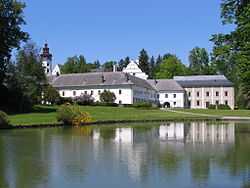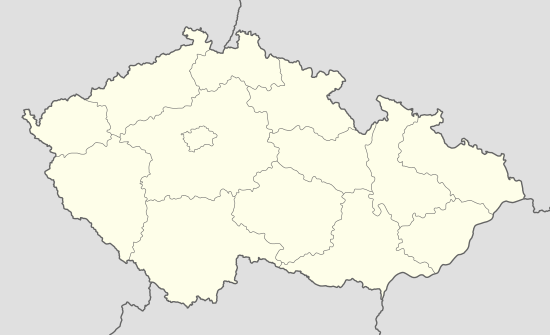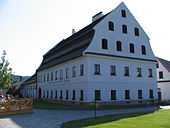Velké Losiny
| Velké Losiny | ||
|---|---|---|
| Municipality | ||
 | ||
| ||
 Velké Losiny | ||
| Coordinates: 50°2′19″N 17°2′41″E / 50.03861°N 17.04472°ECoordinates: 50°2′19″N 17°2′41″E / 50.03861°N 17.04472°E | ||
| Country |
| |
| Region | Olomouc | |
| District | Šumperk | |
| Area | ||
| • Total | 46.5 km2 (18.0 sq mi) | |
| Elevation | 406 m (1,332 ft) | |
| Population (2008) | ||
| • Total | 2,832 | |
| • Density | 61/km2 (160/sq mi) | |
| Postal code | 140 00 to 788 15 | |
| Website | http://www.losiny.cz | |
Velké Losiny (German Groß Ullersdorf) is a village and municipality (obec) in Šumperk District in the Olomouc Region of the Czech Republic. It covers an area of 46.5 square kilometres (18.0 sq mi), and has a population of 2,832 and lies approximately 10 kilometres (6 mi) north-east of Šumperk, 52 km (32 mi) north of Olomouc, and 188 km (117 mi) east of Prague. Its most popular tourist sites are the château, the spa and the handmade paper mill, the oldest in Europe.
The chateâu
Built from 1581-1589 on the site of an earlier Gothic fortress by Jan the Younger of Žerotín, the chateâu and its estates remained in the possession of the ancient Moravian dynasty of Žerotín for more than 300 years.[1] The chateâu consists of three wings overlooking the courtyard with three floors of arcade galleries and is crowned by a narrow octagonal tower. Although Jan was infamous for his ruthlessness towards his subjects, bullying them into woring using methods that were exceptionally cruel even for those days, his descendant Přemek II was worse; in 1662 he had the three ringleaders of a peasant rebellion beheaded.[1] At the turn of the 18th century the Renaissance buildings were extended with a further three, also arcaded, Barroque-style wings, to which were added a Baroque-style garden featuring romantic little structures and statues.
At the end of the 18th century the Žerotíns fell into debt and began selling their estates. In 1802 they had to sell the family seat in Velké Losiny to the Princely Family of Liechtenstein, in whose possession it remained until 1945.
According to unfounded reports the Austrian poet Franz Grillparzer stayed in the chateâu in the 19th century; he was supposed to have based his tragedy The Matriarch on the sad romantic story of the ghostly Žerotín protectoress.[1] The chateâu interiors are among the most remarkable Renaissance spaces in the Czech Republic and most beautiful of all is the banqueting hall with panelled ceiling. The picture gallery houses an outstanding collection of Italian, Dutch and Flemish paintings from the 17th and 18th centuries. The Žerotín armoury contains a collection of pistols and guns made by master gunsmiths at home and abroad from the 17-19th centuries.
The spa
Velké Losiny is a minor spa village. Earlier records of its sulphur springs with temperatures ranging from 22-30 °C, date back to 1576. The spa itself was first mentioned in 1592; sulphuric water being brought from the marshlands to the baths established at that time. The spa buildings are today situated within a park, which, created in 1861, contains rare trees, rhododendrons and azaleas. The spa specialises in treating mobility disorders and children's respiratory problems. The healing process aided by the nice atmosphere and clean air.
The paper factory

The distinguishing feature of the village is an old paper factory in which paper was handmade. Housed in a Renaissance building, several storeys high, it was established by the Žerotíns in the 1590s,[2] but only produced real wealth in the second half of the 19th century. The much sought-after paper has been used by the central European nobility and governments for centuries. Not only it is the oldest paper factory in Central Europe, but it has also been in continuous operation since it was founded.
Paper is still made in the traditional way, namely by hand. The pulp is placed on pumping nets, soaked in animal solution and dried with warm air in the attic drying rooms. The high quality paper, still bearing the family's coat of arms on its watermark, is used for important state and personal correspondence, international contracts and for printing valuable handwritten facsimiles and collectors' items.
Today the factory houses a museum. The only one of its kind in the Czech Republic, it presents the history of paper-making from the use of the old traditional techniques right up to the deployment of modern industrial technologies.
See also
References
- ↑ 1.0 1.1 1.2 Petr David, Vladimír Soukup, Lubomír Čech, Wonders of Bohemia, Moravia and Silesia, pg. 208-209, Euromedia Group (2004), ISBN 978-80-242-2455-8
- ↑ Rob Humphreys, Tim Nollen, Rough guide to the Czech & Slovak Republics, pg. 398, Rough Guides 6th ed. (2002), ISBN 1-85828-904-1
External links
| Wikimedia Commons has media related to Loket. |
- Mumicipalities of Šumperk District Olomouc Regional Statistical Office
- České Hory Website (Czech)
